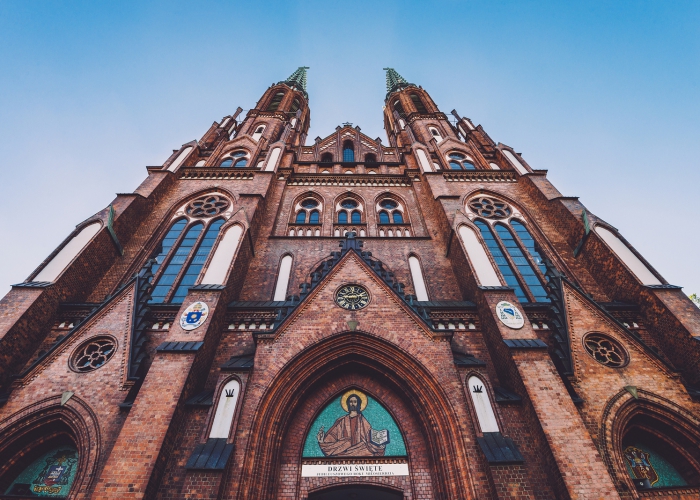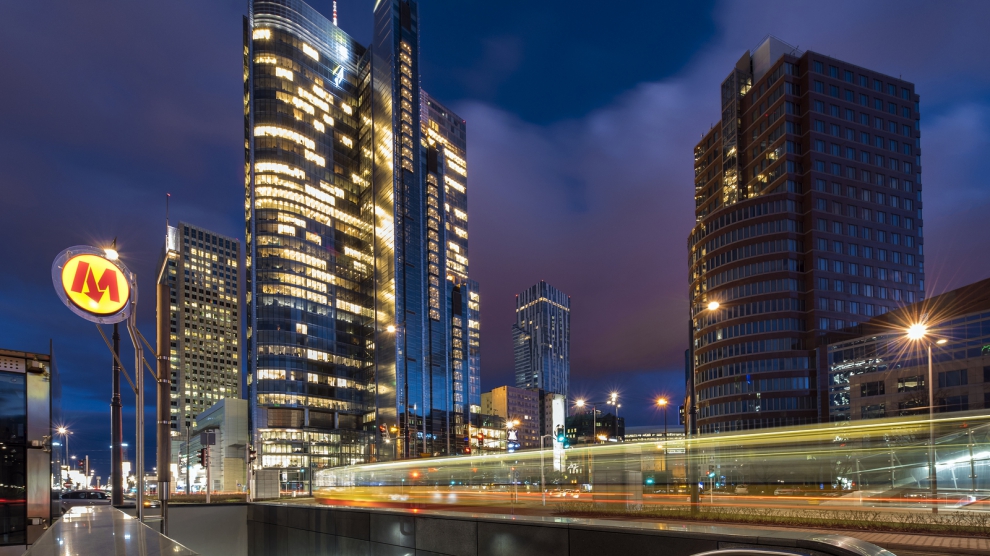This city of 1.8 million has seen and survived it all: the last century alone saw Nazis roll in one way, and the Soviets from the other. Both left a legacy that lasts to this day. Though shaped by a horrific history, Warsaw has risen from the ashes to become a forward-thinking city of confident swagger.
Why Visit Now?
Because tomorrow, it won’t be the same. Changing with each day, the strange organism that is Warsaw has reached a thrilling stage of its rapid evolution: to visit is to witness living history.
DAY 1
Beginnings
Chopin Airport sits approximately seven kilometres from the city centre, a trip that should rarely cost more than PLN 35 by taxi. Befitting of its growing status as Central Eastern Europe’s economic engine, the city centre bristles with towering financial fortresses – the EU’s tallest skyscraper is slated for unveiling in the coming few years. Represented inside many of these glass compounds are the ubiquitous titans of five-star hospitality; for something more personal book into H15 (ul. Poznanska 15, h15boutiqueapartments.com): occupying the seat of the former Soviet Embassy, it’s a design-minded masterpiece that’s not short on Italian influences and trimmings. On a more moderate scale, Autor Rooms (ul. Lwowska 17, autorrooms.pl) is centred around a neo-hipster communal living space – vinyl library included – with four offshoot bedrooms bragging custom-made furnishings and signature pieces from upcoming local designers.
The Old Town
All twittens and tenements, the Old Town charms all with its gurning gargoyles and tight cobbled streets. Looking at it, it’s hard to believe that this UNESCO-listed area suffered near total destruction during WWII – largely overlooked, the modestly-sized Heritage Interpretation Centre (ul. Brzozowa 11/13, ciz.muzeumwarszawy.pl) examines the city’s methodical annihilation and subsequent reconstruction. Close by, the relaunched Museum of Warsaw (Rynek Starego Miasta 42, muzeumwarszawy.pl) tells the town’s story in an awkward but compelling non-linear style that places an emphasis on recovered objects and quirky trivia (random factoid: Warsaw’s first official strip club opened in 1957).
Local Villain
Gifted to Poland by Stalin, the country’s tallest building – the Palace of Culture & Science (Pl. Defilad 1, pkin.pl) – continues to divide public opinion. Seen by some as one of the planet’s greatest examples of Socialist Realist architecture, others bitterly interpret it as a giant phallus born from ideological insanity. Not for the first time, debate is raging whether to demolish it or protect it. For all that, a visit feels almost mandatory – not just for the blustery 40th floor viewing platform, but also for a tour of the labyrinthine basements that coil underground.

Local Heroes
Visitors understand the spirit of Warsaw a little more having visited the Rising Museum (ul. Grzybowska 79, 1944.pl). Dedicated to the anti-Nazi 1944 rebellion that cost the city the lives of more than a quarter of a million of its residents, this museum traces the story of the insurgency in minute detail – right the way from the German invasion and occupation to the smouldering consequences that followed. Elsewhere, Polin, a.k.a. The Museum of the History of Polish Jews (ul. Anielewicza 6, polin.pl), resists the temptation to put the Holocaust at its core and forms its narrative around the epic 900-year-history of Polish Jews. Awarded the title of European Museum of the Year in 2016, it’s a venue that commands attention – to pick a highlight, then that’s the glorious reconstruction of the synagogue in Gwoździec.
Part(y)ing Shot
Where once local habitants were regarded as cautious, selfish and suspicious, the modern Varsovian has dropped his guard and embraced the scary idea of ‘doing things with strangers’. Food halls are trending, none more so than Hala Gwardii (Pl. Mirowski 1, halagwardii.pl), a red brick Tsarist relic brimming with globally-inspired food outlets that frame a lively communal eating area. Hala Koszyki (ul. Koszykowa 63, koszyki.com) is similar, if slightly more upmarket, and flourishes the added trump card of being walking distance from ul. Poznanska: heavily sprinkled with wine bars and neo-bistros, few streets have caught the zeitgeist in quite the same way. Not that far further beyond, Nowogrodzka street has become the de facto capital of Poland’s craft beer revolution. Kufle I Kapsle (ul. Nowogrodzka 25, kufleikapsle.pl), with its pre-war style and enthusiastic representation of domestic rebel breweries, is particularly recommended.

DAY 2
The Other Side
Raw, gritty, upcoming: all words used to describe Warsaw’s right bank. Giant murals have sprung up on the walls of Old Praga’s buildings, adding pops of arty colour to this blue collar district. The looming spectre of gentrification has left a scattering of galleries and museums in its wake and none make a bigger impact than the Neon Museum (ul. Minska 25, neonmuzeum.org): it’s a dazzling assembly of rescued communist era signage.
Tour With A Twist
Beginning (or sometimes ending), at the Museum of Life Under Communism (in itself, a remarkable collection of one man’s sentimental junk), Adventure Warsaw (ul. Głucha 3A, adventurewarsaw.pl) conduct the best tour of town. Peppered with inside knowledge and personal anecdotes, journeys are conducted in wheezing militia vans and take in more than just the obvious commie landmarks to include stops at scruffy markets, ramshackle milk bars, and local pubs for gherkins, vodka and outrageous tales.
Retail Therapy
Those who doubt the oft-aired local boast that this was once ‘the Paris of the East’ could do worse than heading to Mokotowska street back on the left side of town. Here, teetering pre-war tenements have found their ground floor units hijacked by the doyens of Polish fashion. Thick with chic boutiques, salons and lifestyle stores, the mere existence of Mokotowska gives the city’s style mavens the sensation of being on-edge and en-vogue.
The Last Supper
Wojciech Modest Amaro is the godfather of modern Polish cooking and his Michelin-starred restaurant, Atelier Amaro (ul. Agrykola 1, atelieramaro.pl), excels at pushing boundaries. Though prices are steep, this is not just for the 1 per cent, it’s a place to save up for and savour: this is a venue that truly excites via its unconventional interpretations of forgotten ingredients. More affordable, Bez Gwiazdek (ul. Wislana 8) has emerged to become one of the city’s most important restaurants. Certified by the country’s nascent Slow Food movement, their tasting menu changes each month to focus on a different region of Poland.
Warsaw in One Paragraph
Learn the A-Z of Warsaw’s history by visiting the Museum of Warsaw, Polin and the Rising Museum. Enjoy the foodie side of New Warsaw at Hala Koszyki and Gwardii before heading into the night to Poznanska and beyond. Set the alarm for a tour with Adventure Warsaw, before splurging out on the boutiques of Mokotowska. Conclude with a dinner to remember at Atelier Amaro.


Amazing that the author could not manage to write an article about modern Warsaw without having the need to resort to mentioning Nazis, WW2 etc. This would be like having to remind the Japanese about Hiroshima, Nagasaki, or Osaka any time someone references those cities. Get over WW2 because it’s seriously beginning to get stale. I am Polish and we are over the war, you as writers should get over it too. People like you keep places like Warsaw back by not letting go of the distant past. Stop. Do you bring up Berlin’s “terrible” past when you reference it? Highly doubtful. Get over it and let us breathe.
Hello LK,
Thanks for the feedback. In my defence, and in reply to your critique: firstly, my article was not about Modern Warsaw. It was about Warsaw. Secondly, I must ask when you last visited? The Warsaw I have known from two decades of living here is a city defined by the war – and what happened after. Today, I live next to Polin, in the middle of the former Ghetto. Thousands visit from abroad to trace the footsteps of exterminated relatives. Before, I lived on Bagatela, in a building in which 20 people were shot during the Warsaw Uprising. I worked for a bit on Wilcza, bullet holes still splay the door. And there was also Chlodna, where you’ll know the bridge once stood overhead. Different risings, same result.
I challenge you to walk one minute in central Warsaw and not see something connected with ‘the war’ you want to ignore.
It’s everywhere in Warsaw. Further, I think most residents would agree that August 1 is the day that defines the city – its soul, spirit, its past and present.
Beyond that, beyond Warsaw, Poland’s most popular museums are not involved with art, they’re involved with Schindler in Krakow, or a concentration camp in Oswieciem, or a WWII museum in Gdansk. And turn on the news. The war, again. Turn it on now, and watch what the politicians are talking about. War. The War. I’m not making this up.
I hope, in my defence, if you read the rest of my article, that you will understand I also have a passion and enthusiasm for the Modern Warsaw you mention. I think I suggest a new side to this city – but I cannot re-invent history and pretend the past never happened. This, I think, would be ridiculous of me.
Thanks for the comment!
Alex
Love the article. I have been to Warsaw few times, but I love it more with every trip. It is such an underrated place, white in reality it is quite underrated. I love how it combines history with modernity. I love exploring it, visiting new places and trying new things. Last time, few weeks ago my friends took me on a culinary trip around their favorite restaurants in the city. I loved it so much, and I had so much delicious Polish food 🙂 My favorite spot was a restaurant called the Akademia. Not only the place itself was very nice and the food excellent, but also the neighborhood was so nice. I really hope to go to Warsaw again soon!